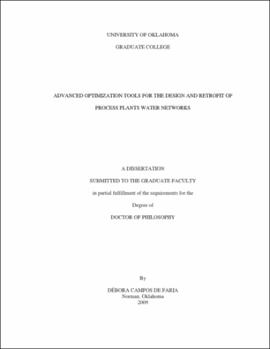| dc.description.abstract | Water is extensively used in industry and due to its increasing cost and the continuous quality deterioration of the available freshwater sources; its use is becoming also a cost concern in industries. An alternative to reduce costs associate to water consumption is the integration of the water system through reuses and recycles. This problem is often called Water Allocation Problem (WAP) and has been studied in the past three decades and several approaches to solve it have been presented. A comprehensive review of methods presented up to 2000 is given by Bagajewicz (2000); additional overviews can be found in a few books (Mann and Liu, 1999; Sikdar and El-Halwagi, 2001). The methods to solve the WAP can be divided into two big classes: those based on mathematical programming, and those based on graphical, heuristic or algorithmic methods. The most promising class is the one based on mathematical programming, which is being increasingly used, especially because of the inability of graphical, heuristic or algorithmic procedures to effectively provide rigorous solutions to multiple contaminant problems. Additionally, more elaborate objective functions (cost, number of connections, etc.) are easier to handle using mathematical programming approaches. Although this problem has been studied for three decades, some conceptual issues have been overlooked. The WAP first defined by Takama et al.(1980) considered two water subsystems commonly seen in the industry, the water-using subsystem and the wastewater treating subsystem, but left the water pre-treatment subsystem out of the systems integration. This work proves that the absence of this third subsystem has a strong effect on freshwater consumption targets and, in many cases, the use of the former definition creates systems that are "impossible" to reach zero liquid discharge. In the mathematical optimization group, approaches using LP, NLP, MILP, and MINLP have been presented. Aside from the linear models presented, which are only able to find the optimum solution for particular situations, the biggest challenge on the mathematical procedures is to overcome the difficulties generated by the non-linear and non-convex terms that arise from the contaminants balance (mixers and splitters). Such problems require good start points to find a feasible solution and most of the available solvers cannot guarantee global optimality if a solution is found. On the other hand, methodologies based on mathematical optimization are much easier to describe the problem in more detail and thus more complex problems can be approached. Although the integrated water system problem has been solved by other authors for minimum freshwater consumption and cost (Takama et al., 1980; Alva-Argaez et al., 1998; Huang et al., 1999; Karuppiah and Grossmann, 2006; Bagajewicz and Faria, 2009; Faria and Bagajewicz, 2009), robust methods to find optimum and sub-optimum solutions, present the option of investigating alternative solutions and are able to analyze the problem from different perspectives are needed. To overcome this drawback, different global optimization methods to solve the WAP using the complete water system are presented. Additionally, a method to find several alternative solutions is described and a planning model is suggested. | |
